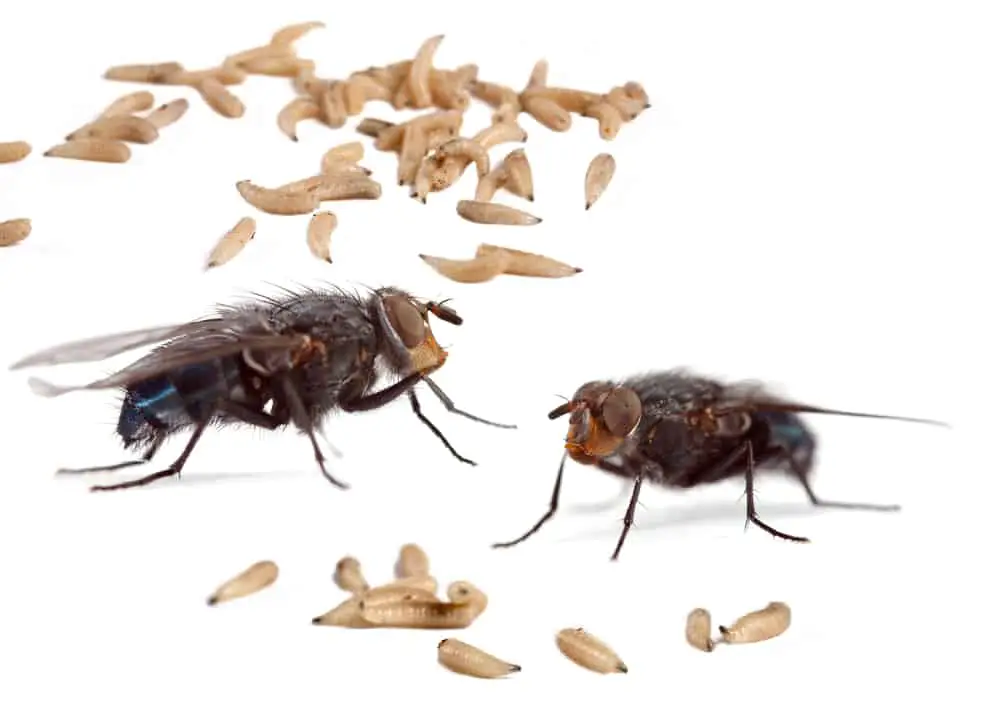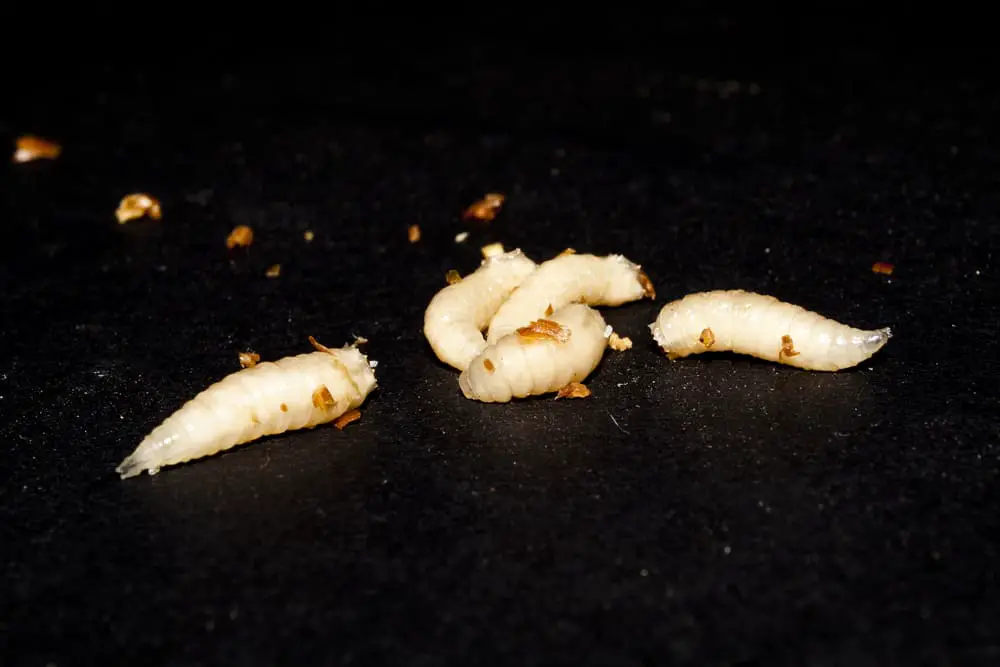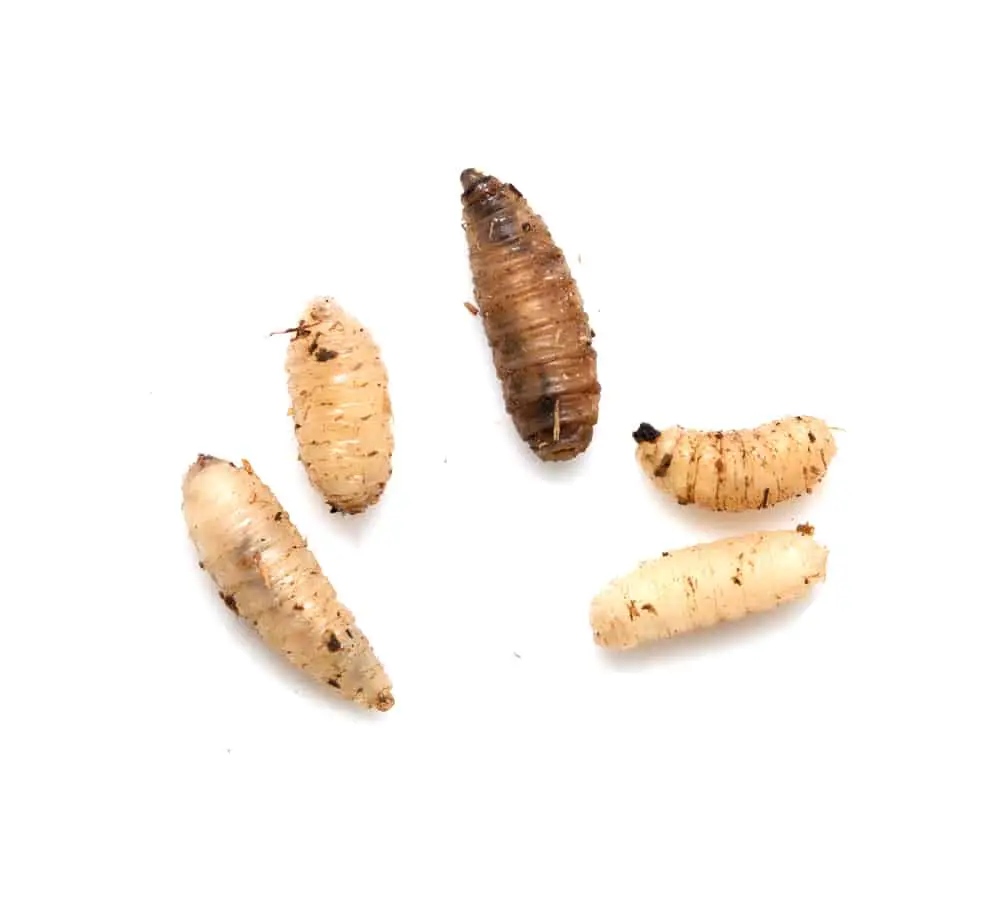While these wriggling creatures might not be the most pleasant sight, their presence often elicits curiosity, particularly when they seemingly appear in sealed containers.
How do these tiny larvae manage to find their way into secured environments?
In cases where maggots seem to mysteriously appear, it is important to understand the life cycle of flies and the factors that attract them.
Adult flies are drawn to suitable environments for laying their eggs, such as decomposing organic matter, spoiled food, or even open wounds on living organisms. The eggs, once laid, hatch into maggots, which then feed on the available nutrients before pupating into their adult forms.
Maggots and their Life Cycle

Maggots are the larval stage of flies, and understanding their life cycle is important in comprehending how they can form in a sealed container. The fly life cycle consists of four main stages, eggs, larvae (maggots), pupae, and adult flies.
From Eggs to Larvae
Adult flies lay their eggs in suitable environments, often in decaying organic material, such as rotting food or animal cadavers. Within a short period (usually 24 hours), the eggs hatch into larvae, also known as maggots.
Maggots are small, white, legless creatures that primarily feed on the decaying matter surrounding them. As they grow, they will go through several developmental stages called instars. During each instar, the maggot will molt – shedding its exoskeleton to accommodate its increasing size.
Pupae to Adult Flies
Once the larvae have reached a certain size and consumed enough nutrients, they will enter the pupal stage. The maggot forms a protective case around itself, known as a puparium, and undergoes a complete metamorphosis within the pupa.
Through the pupal stage, the internal structures of the maggot undergo significant changes, transforming the creature from a legless larvae into a winged adult fly. After a specific period, which may vary depending on the species and environmental conditions, the adult fly emerges from the pupa, fully formed and ready to begin the life cycle anew.
Given the right conditions, flies can multiply rapidly and establish large populations in a relatively short time. Understanding the life cycle of maggots helps in addressing issues involving their appearance or infestation, regardless of whether they are in a sealed container or not.
Sealed Containers and Maggot Formation
Penetration and Breeding Grounds
Even in sealed containers, maggots can still form due to small cracks or imperfections in the container’s lid or body. These tiny openings can allow flies to penetrate and lay eggs, which then hatch into maggots. Flies are attracted to containers with food waste inside because they provide an ideal breeding ground.
Containers that are not airtight make this process easier for flies to access the contents. Therefore, selecting the right container is crucial for preventing maggot formation. For example, using closed containers with a tight seal is more effective.
- Use sealed containers with a tight seal
- Inspect containers for cracks or imperfections
Why Certain Foods Attract Flies
Flies are drawn to specific types of food, particularly organic material, and food waste. Some of these foods include rice, fruits, vegetables, and meats. The decaying process of these food items releases odors that attract flies.
To prevent maggots from forming in sealed or closed containers, it’s essential to minimize the presence of contaminants. One way to do this is by managing and properly disposing of food waste.
- Store food waste in airtight containers
- Properly dispose of organic materials
- Clean containers regularly to avoid attracting flies
By considering both the quality of the container and the types of food stored within, it’s possible to minimize maggot formation and maintain a cleaner, safer environment.
Prevention and Control Measures
Proper Storage and Cleaning
One of the most effective ways to prevent maggots is ensuring proper storage and cleaning. Store food items, especially grains, in tightly sealed containers or heavy-duty plastic bags to avoid attracting pests like the Indianmeal moth. Regularly clean your pantry and kitchen, paying attention to possible infestations.
Dispose of waste products properly and always maintain general cleanliness to discourage the buildup of organic matter.
- Pest control: Invest in regular pest control services to keep insects at bay.
- Vinegar: Use white vinegar while cleaning surfaces, as it helps degrade enzymes and deter insects.
- Sealed containers: Opt for airtight containers to avoid easy access for insects.
Using Insecticides
If you already have an infestation, consider using an insecticide to control maggots. There are various chemical options available in the market, such as:
- Permethrin spray: A synthetic insecticide that can effectively kill maggots and other insects.
- Boric acid: A natural insecticide that can help control pests, but it should be used with caution as it can be toxic.
When using insecticides, follow instructions and guidelines provided by the manufacturer to ensure the safety and effectiveness of the product.
Natural Remedies
For those who prefer natural solutions, there are numerous home remedies to control maggots and other pests. Some of these include:
- Vinegar: As mentioned earlier, white vinegar can help keep insects away due to its strong scent and ability to degrade enzymes.
- Essential oils: Some essential oils, like lavender, mint, and eucalyptus, have insect-repellent properties. Make sure to dilute the essential oil with water and spray it around areas prone to infestations.
Associated Health Risks and Dangers
Infestations and Diseases
Maggots in sealed containers can lead to infestations in various environments. If the seal is compromised, maggots may spread to other food sources, leading to spoiled food and contamination risks. When consuming such food, individuals might face food poisoning symptoms.
One of the most concerning diseases linked to maggots is myiasis. This condition is caused by flies’ larvae infesting a person or an animal’s tissue. Certain species, like Dermatobia hominis or screw worms, can cause severe damage, resulting in meningitis or even death if left untreated.
Preventing Contamination and Illness
To reduce the risk of maggot infestations and associated health dangers, take the following precautions:
- Store food in properly sealed containers, and inspect them regularly for any signs of damage or infestation.
- Dispose of spoiled food promptly to prevent the growth of maggots in your environment.
- Keep living spaces clean, ensuring that there are no breeding grounds for flies or other insects.
To treat already contaminated foods and surfaces, consider using boiling water as a safe and effective method to destroy maggots.
Remember to keep a close eye on your pets, as they may be more susceptible to infestations like myiasis. In case of any signs of infection or infestation, consult a veterinarian for appropriate treatment.
Impact on Environment and Animals

Decay and Organic Matter Breakdown
Decay and the breakdown of organic matter are essential processes in nature. Decomposing organisms like plants, dead animals, and other organic materials release essential nutrients back into the soil. This, in turn, helps other plants grow and thrive, contributing to a healthy ecosystem.
Heat and moisture play a significant role in the decomposition process. Elevated temperature accelerates the breakdown, while moisture provides the ideal environment for decomposers like bacteria and fungi. When garbage accumulates, the trapped heat and moisture combine to create an ideal microclimate for decomposition.
Maggots and their Role in Ecosystem
Maggots, the larvae of flies, have a crucial role in breaking down decaying organic matter. They are attracted to decaying flesh in animal carcasses and body cavities, speeding up the process of decomposition and recycling nutrients back into the environment.
Maggots consume decaying organic material and contribute to its breakdown, ultimately transforming waste into valuable resources for other organisms.
It’s essential to note that maggots only form in sealed containers under certain conditions, like when there is:
- A sufficient amount of decaying matter inside the container
- Availability of moisture and heat
Maggots serve as an essential part of the ecosystem, efficiently breaking down waste, returning nutrients to the Earth, and providing sustenance for other organisms. They are an integral part of the natural cycle of life and death that occurs in our environment daily.


